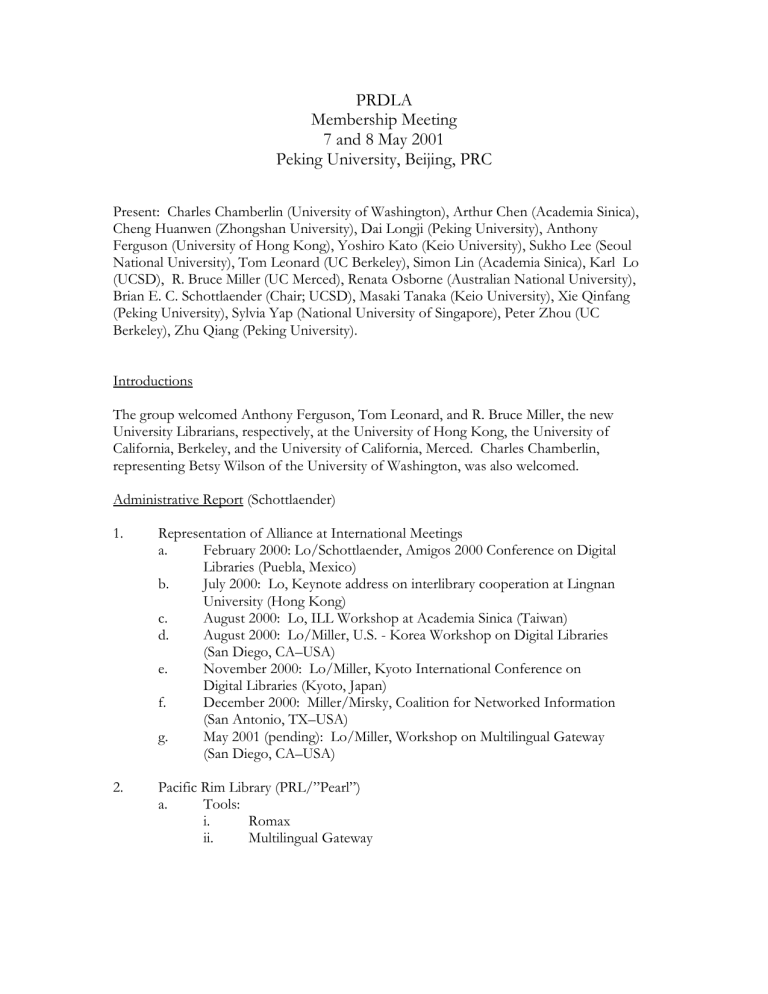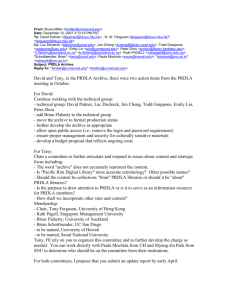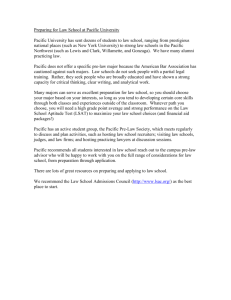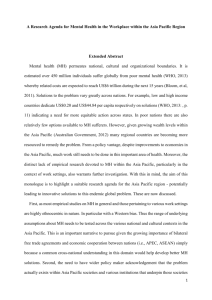2001 Membership Meeting Minutes

PRDLA
Membership Meeting
7 and 8 May 2001
Peking University, Beijing, PRC
2.
Present: Charles Chamberlin (University of Washington), Arthur Chen (Academia Sinica),
Cheng Huanwen (Zhongshan University), Dai Longji (Peking University), Anthony
Ferguson (University of Hong Kong), Yoshiro Kato (Keio University), Sukho Lee (Seoul
National University), Tom Leonard (UC Berkeley), Simon Lin (Academia Sinica), Karl Lo
(UCSD), R. Bruce Miller (UC Merced), Renata Osborne (Australian National University),
Brian E. C. Schottlaender (Chair; UCSD), Masaki Tanaka (Keio University), Xie Qinfang
(Peking University), Sylvia Yap (National University of Singapore), Peter Zhou (UC
Berkeley), Zhu Qiang (Peking University).
Introductions
The group welcomed Anthony Ferguson, Tom Leonard, and R. Bruce Miller, the new
University Librarians, respectively, at the University of Hong Kong, the University of
1.
California, Berkeley, and the University of California, Merced. Charles Chamberlin, representing Betsy Wilson of the University of Washington, was also welcomed.
Administrative Report (Schottlaender)
Representation of Alliance at International Meetings a. February 2000: Lo/Schottlaender, Amigos 2000 Conference on Digital
Libraries (Puebla, Mexico) b. c. d. e.
July 2000: Lo, Keynote address on interlibrary cooperation at Lingnan
University (Hong Kong)
August 2000: Lo, ILL Workshop at Academia Sinica (Taiwan)
August 2000: Lo/Miller, U.S. - Korea Workshop on Digital Libraries
(San Diego, CA–USA)
November 2000: Lo/Miller, Kyoto International Conference on
Digital Libraries (Kyoto, Japan)
December 2000: Miller/Mirsky, Coalition for Networked Information f. g.
(San Antonio, TX–USA)
May 2001 (pending): Lo/Miller, Workshop on Multilingual Gateway
(San Diego, CA–USA)
Pacific Rim Library (PRL/”Pearl”) a. Tools: i. ii.
Romax
Multilingual Gateway
3. b. Collections:
I. Acquired/Mirrored i. Bibliography of East Asian Studies ii. Scripta Sinica iii. Sikuquanshu iv. Beijing Superstar Digital Library
II. Created by Membership ii. Pacific Exploration’s Archive increasingly misnamed because the content that institutions want to include in it is
Pacific Rim-related, but not Pacific Explorations-related (cf.
ANU “Report from Members” below).
Visits Enroute a. Australia i. Schottlaender/Lo/Miller met with ANU’s Donald Henson (Research
School for Pacific and Asian Studies) and Ewan Maidment (Pacific ii.
Manuscripts Bureau) to discuss the Pacific Island Heritage digital project for which they intend to solicit 2002/2003 Australian
Research Council funds.
Schottlaender/Lo/Miller met with Colin Steele/Sally-Anne
Leigh/Renata Osborne of ANU Libraries to review their investigations into using the Content DM software developed at the
University of Washington, and now spun off to a private company called DiMeMa, as a platform for managing locally created digital b. iii.
Japan image objects. Also reviewed with them additional content they are prepared to add to the Pacific Explorations Archive.
Schottlaender/Lo/Miller met with Jan Fullerton, David Toll,
Warwick Cathro, and others of the National Library of Australia, which has many interesting and relevant digital collections. The NLA is interested in affiliation depending on decisions taken in Beijing as regards expanding PRDLA membership.
Schottlaender/Lo/Miller met with Yoshiro Kato of Keio University, who confirmed the willingness of Keio University to co-host, along with Waseda
University, next year's PRDLA Membership Meeting in Tokyo. Waseda,
Keio, NII, and ICLC, Schottlaender/Lo/Miller also learned, are organizing an International Conference on CJK Digital Library Issues for this coming
October or November in Tokyo. Schottlaender assured Kato that PRDLA will be happy to participate as appropriate.
Activities Reports
Miller noted that 550gB of space have been acquired for PRL storage at the San Diego
Supercomputer Center, 200 of which are already occupied, and another 100 of which are already spoken for. <c.f. Attachment 1: “Pacific Rim Digital Library Alliance
Infrastructure”>
- 2 -
Lo updated the group on developments with the Multilingual Gateway, Romax, the
Bibliography of East Asian Studies, and the Pacific Exploration Archive.
Osborne reviewed with the group three options for proceeding with the PRDLA Digital
Image Database. <c.f. Attachment 2: “PRDLA Digital Image Database Status Report”>
The group endorsed Option A: purchase the 32,000 image Content DM 3.1 standard package for US$9,000.
Reports from Members
Kato (Keio) reported on the Coal Industry Image Database, the Pacific Rim Economic
History Image Database, and the Keio University Special Collections Image Database.
Leonard (UCB) reported on the Chinese Stone Rubbings Project, which is intended to develop a common platform and a core metadata set for international use. He also reported on the Rare Japanese Historical Texts projects, featuring Shinto texts; the
Historical Photos of Shanghai project, being carried out consortially with the University of Lyon and Shanghai Public Library; and the Japanese Historical Maps project.
Yap (NUS) <c.f. Attachment 3: “Chinese Library Homepage [etc.]”> reported on the
Chinese Library Homepage, the Chinese Overseas Collection, and the Le Bao imaging project (19 August 1887 - 31 March 1932).
Lin (AS) reported that the Digital Museum Project is merging with National Digital
Archive (7 institutions). Academia Sinica is helping them analyze their data. He also reported on the Taiwan Governors Archive project (10 million pages, 15 Terabytes), the
Taiwan Old Photos project (ca. 100,000 photos before 1960), and the Chinese Historical
Maps project (300-400 maps, GIS "virtualization" starting with ArcView).
Schottlaender (UCSD) reported on the development of UCSD’s Digital Library Program
(DLP), including Vision, Mission, Goals, and Objectives statements; a DLP Inventory of
31 projects; and a DLP Homepage. The thematic foci of UCSD’s DLP are the Pacific
Rim and Oceanography. The current functional development focus is on Integration.
Cheng (Zhongshan) reported on the Chinese Stone Rubbings project, which will include
35,000 rubbings. Funding includes a $125,000 grant from the Lingnan Foundation and
Y300,000 from university participants.
Osborne (ANU) reported on content ANU is considering adding to the Pacific
Explorations Archive. <c.f. Attachment 4: “Possible ANU Contributions to the Pacific
Explorations Archive”>
Lee (SNU) reported that US$12,000,000 has been put toward creating an image database
("Information Retrieval System for Historical Documents") from four national institutes, including the Li Dynasty Royal Archive and the Council for Asian Art History.
- 3 -
Xie (PKU) reported that PKU has established a Digital Library Team to create a Stone
Rubbings metadata standard based on Dublin Core.
Ferguson (UHK) reported that UHK is developing English language e-journals from
Hong Kong, while the Chinese University of Hong Kong is developing Chinese language e-journals from Hong Kong.
CALIS Demonstration (Zhu)
CALIS, the Chinese Academic Library Information System, was started in 1998 and is
Unicode- and Z39.50-compliant. It includes:
a union catalog to which 119 libraries have contributed 1 million titles and 2 million holdings;
a Chinese Current Contents database to which 24 libraries have contributed 5,000 titles;
a Chinese Dissertation Abstracts database;
ILL and desktop delivery services (for a fee).
Personnel Exchange (Lo)
The Keio/UCSD personnel exchange agreement is very successful. The group agreed that extending these sorts of exchanges to other PRDLA institutions is a desirable objective.
PRDLA and its Virtual Library (Schottlaender)
It is increasingly important to distinguish between PRDLA, the organization, and PRL, the Pacific Rim Library being built by the organization. PRL, the library, includes services (the Multilingual Gateway and Romax tools described earlier) and collections.
PRL collections are acquired (e.g., Siku and Beijing Superstar), mirrored (e.g., Scripta
Sinica), and created (Pacific Explorations Archive).
In the interest of PRL coming to be recognized as the portal to digital content from and about the Pacific Rim, Schottlaender recommends that PRDLA drop “Pacific
Exploration” as an organizing concept and, instead, focus on developing a fully-realized virtual Pacific Rim Library. This library would be characterized by three things: i.
Conceptually, PRL would allow “vertical” access to content by repository and
“horizontal” access to content by geographical area, by subject area, and, perhaps eventually, by time period. ii.
Organizationally, local priorities would drive content development, with interinstitutional synergies being leveraged as opportunities present themselves (e.g.,
Chinese Stone Rubbing Project, Pacific Island Heritage Project). iii.
Technically, a database management system would “assemble” the virtual library by higher-order integration of digital content residing on local servers, and would provide access to that content using metadata created by institutions locally in the process of digital content development.
<c.f. Attachment 5” “Pacific Rim Library (PRL)”>
- 4 -
Advantages of such an approach: i.
Individual PRDLA members are free to develop digital content that is maximally responsive to local constituency needs. ii.
Once the technical infrastructure is in place, content “ingest” becomes very simple, demanding relatively little of local institutions. iii.
Horizontal access integration enriches digital content by providing geographical, topical, and temporal context that repository-level vertical access lacks. iv.
Improved likelihood of extramural funding.
PRDLA Funding and Membership (Schottlaender)
The PRDLA budget has 2 general components: a programmatic component and an operational component. The operational budget, comprising the Program Office (also known as the Executive Director) and a Secretary/Administrative Assistant, is approximately US$30-50,000/year.
Seeking extramural funding support for the operational component of the budget is not sustainable, nor necessarily desirable. Schottlaender believes that PRDLA has now reached the point in its evolution where we need to fund these expenses at a central organizational level. To this end, UCSD is prepared to pay (as is ANU) modest annual
PRDLA membership dues on the order of US$1-2,000/year. The final figure will depend on how many PRDLA members there are over which to amortize the total cost.
Moving to dues-based funding of the operational budget, will free up PRDLA to focus our extramural fundraising efforts on technical infrastructure and content development projects. Moreover, PRDLA’s demonstrating seriousness of purpose by assuming our own operating costs should facilitate our extramural fundraising efforts.
As regards PRDLA membership, a year ago in Seattle the PRDLA Directors decided to postpone adding members for a year and to remain focused on the objectives laid out in the Luce proposal. We are now within 6 months of the end of the Luce project and, more importantly, of the funding it provides. it is now time to pick up the membership issue again and to begin to expand our membership strategically with a view toward expanding our revenue base, our content stream, and our geo-political coverage.
We have already been approached by: i.
Waseda University ii.
Kyoto University iii.
UCLA iv.
National Library of Australia
We could (and should) talk to other potential member sites in Latin America (e.g. Chile),
Australia, China, Japan, the U.S., etc. We need to rely on each other to identify and contact potential sites.
- 5 -
PRDLA Secretariat (Schottlaender)
UCSD has carried out the PRDLA “Secretariat” function since PRDLA’s inception in
1999 and is very much committed to continuing to carry it out through the end of 2001.
Thereafter, Schottlaender feels strongly that another PRDLA member institution should play the Secretariat role, for the following reasons: i.
as an international initiative, not a U.S. or a UCSD initiative, leadership responsibilities for PRDLA should be shared internationally, ii.
three years is enough time for any single institution to play the Secretariat role.
Secretariat functions currently carried out by UCSD, and primarily by Karl Lo in his capacity as PRDLA Executive Director, include (as noted in the 2000 Luce Report): i.
planning and budgeting ii.
programmatic agenda development iii.
identification of technical solutions iv.
identification of information resources v.
development of funding proposals vi.
representation of Alliance at various meetings and to various content/solution providers vii.
membership outreach
In addition, the Secretariat facilitates membership meetings, manages the Web site, and serves as Alliance archivist. The Luce grant has provided fairly robust Secretariat support in the amount of US$50,000 annually for each of the three years of the grant.
It is useful to think of the Secretariat as having 3 components: i.
Executive Leadership (Strategic) ii.
Programmatic Leadership (Tactical) iii.
Secretarial (Operational)
Identifying these three general components is useful because doing so allows us to apportion the long list of responsibilities above amongst the three areas and, therefore, to break the list up into more manageable components.
The explicit identification of the Executive Leadership component allows us to consider alternative approaches to broadening the base of that level of leadership within PRDLA beyond the single institution that volunteers to, and is paid to, assume the programmatic and secretarial responsibilities for the next 2-3 years. ANU’s Colin Steele has suggested to Schottlaender the possibility of a PRDLA “Executive” or “Steering” Committee to include the Director of the new Secretariat site, UCSD (for continuity’s sake), plus 3 or 4 additional PRDLA Directors. This is an interesting idea that Schottlaender recommends the PRDLA Directors consider seriously. Not only will it broaden the PRDLA leadership base as noted earlier, but it will provide PRDLA with broad strategic guidance, and free up the Secretariat site to focus on programmatic management issues.
- 6 -
Executive Session
T. Leonard: Does there need there be a single program officer? Could two people at a single institution do it?
A. Ferguson: Brought to Executive Session with him a list of PRDLA Membership
Benefits he had drawn up based on the discussions of the preceding day. <c.f.
Attachment 6: “Major Benefits Associated with PRDLA Membership”> He is willing to commit his energies and UHK's if there is active leadership from other PRDLA institutions as well. Ferguson proposes a Steering Committee (of PRDLA Directors) and four programmatic subcommittees, each chaired by a member of the Steering
Committee, as follows: i.
consortial licensing of content ii.
metadata iii.
IT/software iv.
resource sharing
The group agreed that it is very important to formalize the organization more and to extend membership.
Schottlaender agreed to have a listserv set up that archives content, and to develop a letter inviting membership from new institutions, with the list of PRDLA membership benefits attached. The group agreed that membership criteria may be necessary, but should be kept simple. The group further agreed to annual membership dues not to exceed US$2,000 and that tiered membership dues rates for full and affiliate members should be considered. The group will brainstorm a list of potential new members on the listserv.
The group agreed that this new organization would be tried for 2 years, then reevaluated.
- 7 -









